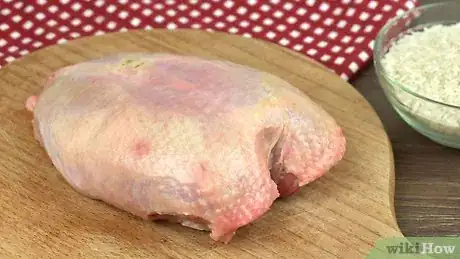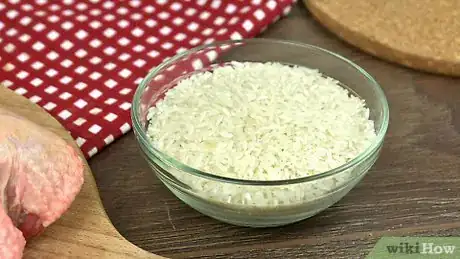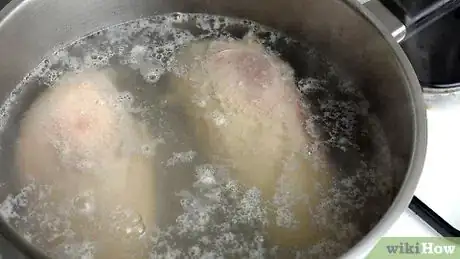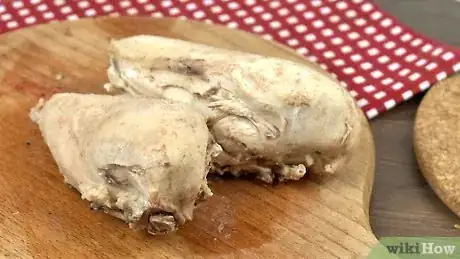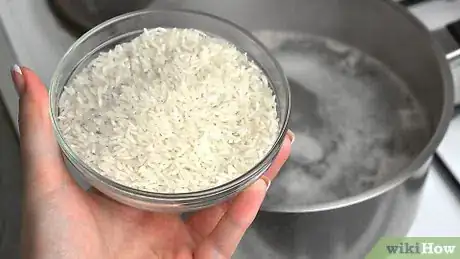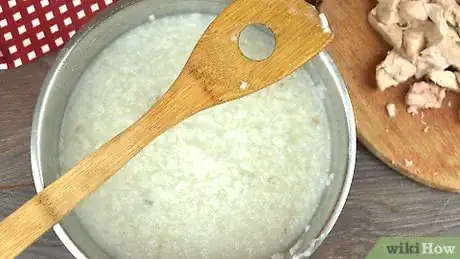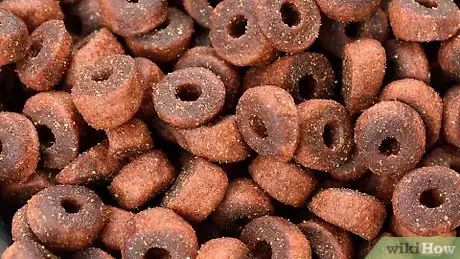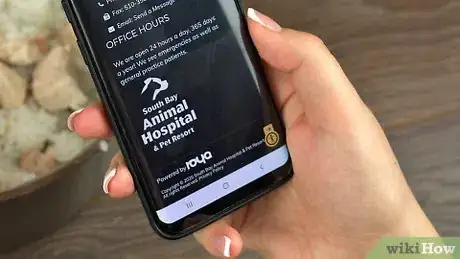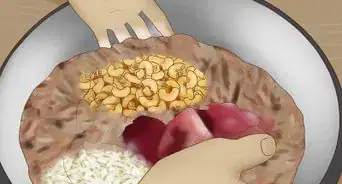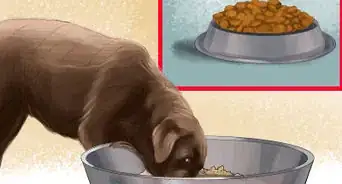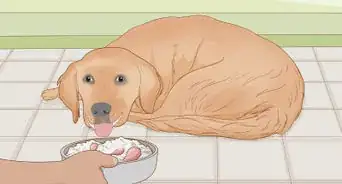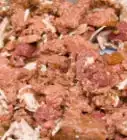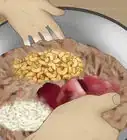This article was co-authored by Pippa Elliott, MRCVS. Dr. Elliott, BVMS, MRCVS is a veterinarian with over 30 years of experience in veterinary surgery and companion animal practice. She graduated from the University of Glasgow in 1987 with a degree in veterinary medicine and surgery. She has worked at the same animal clinic in her hometown for over 20 years.
There are 11 references cited in this article, which can be found at the bottom of the page.
wikiHow marks an article as reader-approved once it receives enough positive feedback. This article received 19 testimonials and 100% of readers who voted found it helpful, earning it our reader-approved status.
This article has been viewed 1,491,508 times.
Homemade chicken and rice is a bland food source often recommended by veterinarians to help dogs recover from diarrhea and/or vomiting. It is an easily digestible low-fat, single-protein, and single-carbohydrate source diet recommended especially for cases of gastrointestinal upset.[1] This protein and starch combination can also stimulate appetite when a dog is ill or recovering from surgery. While it's not recommended for long-term use, cooked chicken and white rice has enough nutritional properties to put your dog back on the road to wellness.
Steps
Preparing to Cook
-
1Purchase the best quality chicken you can afford to limit your dog's exposure to toxins. Boneless chicken breasts are the easiest option because you will not have to remove fat or bones from the chicken.[2]
- Look for chicken that is raised without hormones if possible.
-
2Buy a package of short or long grain white rice. Avoid quick-cooking rice for this dog food recipe, since this product has lower nutritional value than its long-cooking counterpart.[3]
- Brown rice may be used, but it must be cooked longer so that it is fully cooked and soft enough to avoid irritating the dog’s stomach or intestine.
- Some sources may say to avoid brown rice because it has too much fiber, but this is a myth. Fiber helps promote and regulate normal bowel function. Veterinary nutritionists believe that fiber shortens intestinal transit rate in dogs with slow transit time and prolongs the rate in dogs with rapid transit time (in other words, it makes constipated dogs poop, but firms the stool in dogs with diarrhea).[4]
- There is no need to buy organic or non-GMO labeled rice; there has been no evidence to tie these products to change in nutritional quality or arsenic levels in rice.[5]
Advertisement -
3Prepare the chicken for cooking. Chicken can be cooked bone-in, but the meat must be removed from the bone after cooking. However, the chicken will cook faster and more thoroughly if you de-bone and cut it prior to cooking or purchase boneless chicken.[6]
- Cut the chicken off of the bone (or buy boneless chicken) and cut away fat.
- Cube chicken into half-inch cubes for small dogs or 1-inch cubes for medium or large breed dogs. Dogs that are missing many teeth may need to have even smaller pieces of food.
Cooking the Chicken and Rice
-
1Place the chicken in a large stockpot. Fill with enough water to cover the chicken. Bring to a boil then reduce the heat to a simmer. Cook the chicken until the meat is fully white inside.
- The cook time will vary between 10 and 30 minutes, depending on the size of the pieces. Bone-in chicken will need longer.
- If the chicken is not fully cooked, your dog could be at risk for increased diarrhea and vomiting due to the bacteria found in raw or under cooked chicken.
-
2Remove the chicken from the water and allow it to cool completely. Reserve the broth for later use. You can help the chicken cool more quickly by spreading it out on a baking sheet or by placing it in a colander and running cool water over it.
-
3Pull any bones out of the cooled chicken. Separate the meat and discard the bones. Then cut the chicken into pieces that are a half inch or smaller for small breed dogs or one inch or smaller for medium or large breed dogs.[7]
- Be sure that your dog cannot access the chicken bones, either in the chicken pieces or from the trash can. Chicken bones can splinter and become lodged in or puncture your dog’s throat, stomach, or intestines. This could be fatal.
-
4Skim any fat from the top of the cooled chicken broth and pour the remaining fluid into a container. If you cut the fat off of the chicken prior to cooking, there may be little or no fat to skim off. Measure 2.5 cups (591.47 ml) of the chicken broth and pour it back into the pot.
-
5Bring the chicken broth to a boil. While waiting for the broth to boil, you can begin to prepare the rice, which you will cook in the broth.
-
6Measure 1 cup (236.58 ml) of rice (for a big dog !) and rinse it thoroughly. Rinse the rice in a pan, a rice cooker insert, or in a bowl. Use plenty of water and stir the rice around with your fingers while it is submerged. Rinse several times until the water runs clear; this step helps remove excess starches and arsenic from the rice.
-
7Cook the rice in the chicken broth. Once the chicken broth is boiling, pour the cup of rice into the broth. Return to a boil, and then lower the heat to a simmer. Cover with a tightly fitting lid and cook for 20 minutes (brown rice will likely need 40-45 minutes). The rice will be slightly soggy and soft when done, and all of the water should be absorbed.
-
8Allow the cooked rice to completely cool. The process can be expedited by spreading the rice out on top of a baking pan and fanning it with a sheet of cardboard.
Feeding your Dog
-
1Add the cooked chicken to the rice and blend with a fork. Your rice to chicken ratio should be between 2:1 and 3:1. For example, 2 to 3 cups of rice should be mixed with 1 cup of chicken.[8]
-
2Serve your chicken and rice dog food in your dog’s normal dish. Follow your veterinarian’s instructions about feeding the dog, but generally, you would feed a little at a time to a dog that has been vomiting. If your dog holds the food down, give him a bit more the next time, working your way towards a full portion at your dog’s regular meal times.
-
3Transition from chicken and rice to regular dog food. After several days of successful chicken and rice food, you can begin to add the dog’s normal kibble into the chicken and rice mix. Add more kibble each day, reducing the amount of chicken and rice, as you gradually transition back to a normal diet over a period of 4-5 days.[9]
- Be sure to consult your veterinarian about the transition back to normal food. Depending on the dog’s specific condition, you may need to feed the dog a chicken-and-rice diet longer than a few days.
-
4Call your veterinarian if the dog's symptoms don't improve. The chicken and rice diet is meant to be a temporary at-home treatment. If your dog’s diarrhea is not cleared in the expected time frame given to you by your veterinarian, or the diarrhea stays very watery for 3 days or more, call your veterinarian immediately. Your veterinarian will tell you if you need to bring your animal in for a recheck and may send home additional medication or give you some advice over the phone of what to do next, such as adding in canned pumpkin or other easy things to try.
Expert Q&A
-
QuestionHow much chicken and rice should I feed my dog with diarrhea?
 Pippa Elliott, MRCVSDr. Elliott, BVMS, MRCVS is a veterinarian with over 30 years of experience in veterinary surgery and companion animal practice. She graduated from the University of Glasgow in 1987 with a degree in veterinary medicine and surgery. She has worked at the same animal clinic in her hometown for over 20 years.
Pippa Elliott, MRCVSDr. Elliott, BVMS, MRCVS is a veterinarian with over 30 years of experience in veterinary surgery and companion animal practice. She graduated from the University of Glasgow in 1987 with a degree in veterinary medicine and surgery. She has worked at the same animal clinic in her hometown for over 20 years.
Veterinarian The key to feeding a dog with diarrhea is to feed them little and often. Divide up the equivalent of their daily ration of a bland diet and offer it in small portions four to six times a day. This causes less stimulation to the stomach which reduces muscular contraction of the gut wall and helps ease diarrhea.
The key to feeding a dog with diarrhea is to feed them little and often. Divide up the equivalent of their daily ration of a bland diet and offer it in small portions four to six times a day. This causes less stimulation to the stomach which reduces muscular contraction of the gut wall and helps ease diarrhea. -
QuestionAre rice and chicken good for dogs?
 Pippa Elliott, MRCVSDr. Elliott, BVMS, MRCVS is a veterinarian with over 30 years of experience in veterinary surgery and companion animal practice. She graduated from the University of Glasgow in 1987 with a degree in veterinary medicine and surgery. She has worked at the same animal clinic in her hometown for over 20 years.
Pippa Elliott, MRCVSDr. Elliott, BVMS, MRCVS is a veterinarian with over 30 years of experience in veterinary surgery and companion animal practice. She graduated from the University of Glasgow in 1987 with a degree in veterinary medicine and surgery. She has worked at the same animal clinic in her hometown for over 20 years.
Veterinarian Chicken and rice are easily digestible sources of carbohydrate and protein, which is great for settling upset stomachs. However, when fed in the long term, it is not adequately balanced and a more varied diet is considered essential.
Chicken and rice are easily digestible sources of carbohydrate and protein, which is great for settling upset stomachs. However, when fed in the long term, it is not adequately balanced and a more varied diet is considered essential. -
QuestionCan I feed my dogs chicken breast and rice long-term?
 Pippa Elliott, MRCVSDr. Elliott, BVMS, MRCVS is a veterinarian with over 30 years of experience in veterinary surgery and companion animal practice. She graduated from the University of Glasgow in 1987 with a degree in veterinary medicine and surgery. She has worked at the same animal clinic in her hometown for over 20 years.
Pippa Elliott, MRCVSDr. Elliott, BVMS, MRCVS is a veterinarian with over 30 years of experience in veterinary surgery and companion animal practice. She graduated from the University of Glasgow in 1987 with a degree in veterinary medicine and surgery. She has worked at the same animal clinic in her hometown for over 20 years.
Veterinarian The risk with this as a long-term diet is the dog may become deficient in certain vitamins and minerals. Dietary deficiencies may not become obvious for months or even years, so there will be a delay before any problems start to occur. With this in mind, if chicken and rice is your choice for a long-term diet, speak to a qualified veterinary nutritionist about a recipe or supplements that are appropriate for your dog's age, size, and health issues.
The risk with this as a long-term diet is the dog may become deficient in certain vitamins and minerals. Dietary deficiencies may not become obvious for months or even years, so there will be a delay before any problems start to occur. With this in mind, if chicken and rice is your choice for a long-term diet, speak to a qualified veterinary nutritionist about a recipe or supplements that are appropriate for your dog's age, size, and health issues.
Warnings
- This bland diet is not meant to be a complete feed for the long term. There are essential vitamins and minerals that would be missing if your dog is only on chicken and rice its whole life. Consult a veterinarian about sources of good homemade diet recipes, if you are seeking to make homemade food for your dog regularly.⧼thumbs_response⧽
- If your dog continues to vomit, call your veterinarian immediately. Dogs (especially small dogs) can become dehydrated very quickly with vomiting, so it is critical to keep them hydrated for their illness to improve. The more dehydrated they become, the worse their symptoms will get and it will begin to affect other organs, such as the kidneys.⧼thumbs_response⧽
- Do not use any oils and remove all fats from the meat you cook. These compounds require the pancreas to work harder to digest and this can cause inflammation in this organ.[11]⧼thumbs_response⧽
Things You'll Need
- Chicken
- White rice
- Stock pot
- Water
- Measuring cups
References
- ↑ Tilley LP, Smith FWK. The 5-Minute Veterinary Consult: Canine and Feline, 3rd Edition. Lippincott, Williams and Wilkins, 2004: p. 1359.
- ↑ https://www.sciencedaily.com/releases/2013/05/130513095030.htm
- ↑ http://www.berkeleywellness.com/healthy-eating/food/article/types-rice
- ↑ Hand MS, Thatcher CD, et. al. Small Animal Clinical Nutrition, 4th Edition. Mark Morris Institute, 2000: p. 171.
- ↑ https://www.consumerreports.org/cro/magazine/2015/01/how-much-arsenic-is-in-your-rice/index.htm
- ↑ https://www.chatelaine.com/food/kitchen-tips/how-long-to-cook-chicken/
- ↑ https://www.fda.gov/ForConsumers/ConsumerUpdates/ucm208365.htm
- ↑ https://www.ardmoreah.com/pet-care/diarrhea-protocol-for-dogs/
- ↑ Tilley LP, Smith FWK. The 5-Minute Veterinary Consult: Canine and Feline, 3rd Edition. Lippincott, Williams and Wilkins, 2004: p. 1359.
About This Article
If your dog has an upset stomach, your vet may recommend chicken and rice to help settle it. If possible, choose high-quality chicken breast that is free of added hormones. The cooking process will also be easier if you get chicken that already has the bones, skin, and excess fat removed. Short or long-grained white rice works best, but you can also use brown rice. To prepare the chicken, remove any skin and bones, then cut the meat into small cubes. For smaller dogs, make the cubes about 0.5 inches (1.3 cm) across. For medium to large breeds, they can be 1 inch (2.5 cm). Make sure you completely remove any bones, since they could damage your dog’s stomach or intestines. Put the chicken in a large pot with enough water to completely cover the meat. Bring the water to a boil, then reduce the heat and let it simmer until the chicken is white all the way through. This may take anywhere from 10 to 30 minutes. Once the chicken is cooked, take it out of the water and let it cool completely. Set aside the broth you created, since you’ll be using it to cook the rice. While the chicken is cooking, skim the fat off the top of the broth and measure out 2.5 cups (591 mL) into a pot. Bring the broth to a boil, then pour in 1 cup (210 g) of well-rinsed rice. Return the broth to a boil, then reduce the heat and let it simmer with a lid on for about 20 minutes. If you’re cooking brown rice, you may need 40 to 45 minutes. The rice is done once it’s nice and soft and all the water is absorbed. To feed the chicken and rice to your dog, wait for them to cool completely. Then, mix the chicken into the rice with a fork. Aim for a ratio of about 2-3 parts chicken to 1 part rice. Follow your vet’s instructions to determine how much chicken and rice to feed to your dog at a time, and how and when to transition your pup back to its regular diet. For more tips from our Veterinary reviewer, including how to transition from chicken and rice food to regular dog food, read on!
